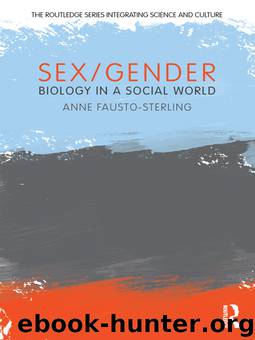Sexgender by Fausto-Sterling Anne

Author:Fausto-Sterling, Anne
Language: eng
Format: epub
Publisher: Taylor & Francis (CAM)
Published: 2012-02-25T16:00:00+00:00
O.K., O.K. but What about Biology?
At a recent scientific meeting on the biology of sex differences a top scientist in the field averred to an audience of several hundred rapt listeners that, with regard to sex and sexual desire, men are really very simple. They are either heterosexual and thus masculine in interests and desires or homosexual and thus feminized in interests and desires. Hardly any men, he said, are intermediate in desire. Women, the speaker agreed, were probably not so simple and so he focused more on what we think we know about men.
But what, exactly are masculine and feminine men? One need only look at images of seventeenth-century men, dressed in frills and wigs, with rouge reddening their cheeks, to know that our ideas about masculinity and femininity have changed over the years. More recently (from roughly 1967 to the present) scientists who study sexuality have also gradually changed their conceptualization of masculine and feminine sexuality.
In the late 1960s scientists viewed sexual intercourse (penile-vaginal penetration) as the unique spot where masculine and feminine met (as seen in Figure 6.4, reprinted from Jordan-Young, 2010). In theory, masculine men desired only women and their only goal for sex was the sex act itself. Feminine women were understood to desire only men, but their goals for the sex act were love and motherhood. Beyond that, a person with masculine sexuality masturbated, actively pursued sexual contact, had a high libido, had erotic dreams, had multiple sex partners, and was aroused by visual imagery. Theoretically, a person with feminine sexuality did not masturbate, focused on their loved one, was monogamous, romantic, had no erotic dreams, and was aroused only by direct touch. This understanding of masculine and feminine sexuality shaped research on both hetero and homosexuality during the 1960s and 1970s in very specific ways—of which more in a moment.
Figure 6.4 How brain organization researchers divided activities and desires into masculine and feminine in their early studies, roughly 1967 through 1980.
Download
This site does not store any files on its server. We only index and link to content provided by other sites. Please contact the content providers to delete copyright contents if any and email us, we'll remove relevant links or contents immediately.
| African-American Studies | Asian American Studies |
| Disabled | Ethnic Studies |
| Hispanic American Studies | LGBT |
| Minority Studies | Native American Studies |
Cecilia; Or, Memoirs of an Heiress — Volume 1 by Fanny Burney(32440)
Cecilia; Or, Memoirs of an Heiress — Volume 2 by Fanny Burney(31875)
Cecilia; Or, Memoirs of an Heiress — Volume 3 by Fanny Burney(31858)
The Great Music City by Andrea Baker(31539)
We're Going to Need More Wine by Gabrielle Union(18973)
All the Missing Girls by Megan Miranda(15597)
Pimp by Iceberg Slim(14399)
Bombshells: Glamour Girls of a Lifetime by Sullivan Steve(13979)
Talking to Strangers by Malcolm Gladwell(13233)
Norse Mythology by Gaiman Neil(13216)
Fifty Shades Freed by E L James(13163)
For the Love of Europe by Rick Steves(13116)
Mindhunter: Inside the FBI's Elite Serial Crime Unit by John E. Douglas & Mark Olshaker(9209)
Crazy Rich Asians by Kevin Kwan(9173)
The Lost Art of Listening by Michael P. Nichols(7412)
Enlightenment Now: The Case for Reason, Science, Humanism, and Progress by Steven Pinker(7242)
The Four Agreements by Don Miguel Ruiz(6640)
Bad Blood by John Carreyrou(6558)
Weapons of Math Destruction by Cathy O'Neil(6152)
